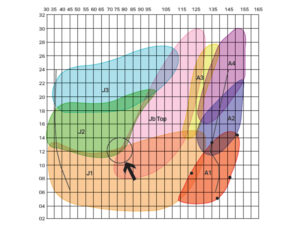
WDemon NOOD Montage
Editor’s note: Dave and Debbie Clasen and the crew of Windemon won the SW Coaching Contest in which they received two free days of coaching from Tony Rey. For more questions or more on the contest, see the articles at right. They finished 20th of 26 Tartan 10s in the 2005 Chicago-Mackinac Race. Dave: How much do tactics differ in port-to-port vs. buoy races? On long-distance races, what are the things the crew should focus on to help maintain speed over longer distances, especially when they have “down time”? Tony: Tactics are a bit different, but the basic concepts are the same. In a long race, it can be helpful to break the race down into shorter races, say 2-4 segments, based on geography (“from the start to this headland 25 miles away”) or weather conditions (“from the last turning mark, to the passage of the expected front”). This way the team is biting off the race in small sections, and trying to win each small race vs. the fleet. A common mistake when racing offshore is focusing on the compass course to the next mark, instead of the boatspeed. On a 50 or 100 mile reaching leg, it’s often faster to sail 10-15 degrees off course, if it means you can carry a faster sail combination (for example, if you have a code zero masthead genoa option instead of a jib, or you can change from a jib to a kite for a while). On a long leg, don’t be afraid to experiment a bit with sail combinations, so you can find the fastest setup. Dave: One of our Mac crew members asks, “What’s the best way to keep track of competition offshore during the day? At night? How often should people be rotated from positions during a long race? Tony: It’s important to keep track of the competition on an offshore race, for two reasons: 1) it helps you to check in to see if your strategy is working 2) it keeps the team fired up to work hard. The best way to keep track is with a hand bearing compass. Have someone take occasional bearings on them, even if they are merely a speck on the horizon, and you can get an idea of how your speed is. For example, if you are steadily pulling bearing on them (making gains), try to guess the time frame (eg. 3-4 degrees every hour), so the next watch can have a benchmark. If it’s nighttime, most handbearing compasses will still work if you shine a flashlight at it’s face for a few seconds, then use it. If you don’t have a handbearing compass, you can line up the competitor with your traveler bar ( knowing it’s more or less 90 degrees to center line), or just shoot a bearing down the boats binnacle or deck mounted compass. Regarding watch rotations, I have sailed with a variety of different systems, and I can’t say I have a preference. The standard two groups, 4 hours on/4 hours off is used most often, or a rotating 4 on/4 off at night, and 6 on/ 6 off at daylight, if the conditions are benign. With your small crew on the T Ten, you may find that the standard 4 hours on/4 hours off works well, but you can choose 1 person on each off watch to be the Standby crew, who has to sleep in their gear, and is the first one called up for any watch changes. Rotate this person every off watch. The other way to divide this up is by the specific conditions you are encountering. If you’ve got some upwind work early in the race (which seemed likely on the forecast I saw!), consider keeping most of the team on the rail, hiking for that first section. It’s tough work, but it may give you the extra edge early. On the 04 Chicago Mac race with Esmeralda, we didn’t go into a watch system until 18 hours into the race, so that we could have the whole team hiking hard through the first night of moderate air/upwind. Not much fun, but very effective,and we did this knowing it would get light in the middle/latter stages, and we could get guys down to rest then. Try to rotate guys through the positions on watch, so that people don’t get too bored, particularly if the conditions are benign.









